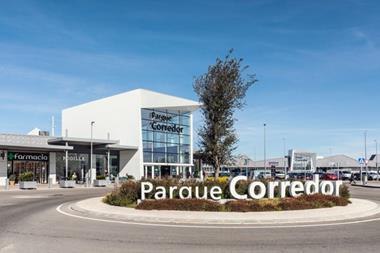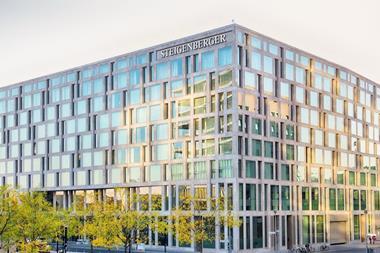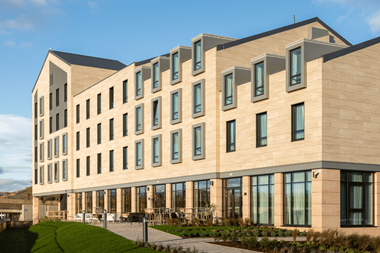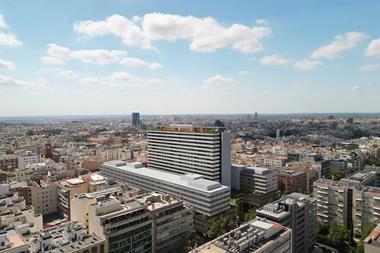Coima’s latest showpiece project in Italy centres on the Milan Cortina Winter Olympics of 2026 and its legacy, but the investor-developer’s long-term goal extends far beyond that, as CEO Manfredi Catella explains in an interview with PropertyEU.

Italian investor, developer and asset manager Coima has become one of Milan’s biggest names in real estate, after building on its decade long success with business district Porta Nuova, plus more recent ventures aiding the regeneration of the city. But as CEO Manfredi Catella explains, Coima’s endgame is not merely deepening the density of Milan, but achieving a long-term, sustainable vision for Italy as a whole that benefits all users.
Porta Romana plans
Catella sees the Porta Romana Railway Yards regeneration project as two distinct phases; preparing the site for use during the Milan Cortina Winter Olympics of 2026, and then securing its post-Games future.
‘Firstly, we have to prepare the Olympic Village for delivery to the Olympic Committee in July 2025,’ he notes. ‘We are well ahead of schedule – by at least four months – and the six buildings have already been topped out.’ He adds: ‘There are four ministries involved, including the Ministry of Sport and the Ministry of Education, plus the Ministry of Infrastructure and the Ministry of Economy & Finance. It is attracting attention because the peculiarity of this project is that it is designed from the very beginning to meet both a temporary use case and the permanent one. The temporary one being the athletes’ village, and the permanent one, affordable and student housing. We designed it to work for both, and we are working on a rapid transition from one to another.’
He adds: ‘In the past, there has been some criticism around expensive, temporary structures built for events, so Olympic legacy plans are incredibly important. As well as ministry-level involvement, the municipalities of Lombardy and Milan are also playing their part.
‘The Olympics aside, the future of the whole neighbourhood is under scrutiny. The development entitlement timeline for these kinds of projects is roughly four years. As we are now at the end of that time period, we expect the urban planning for the site to be approved by the middle of 2025. Our partners for the masterplan are Prada Holding and Covivio, and the collaborative aspect is working very well. The rest of the project will be dominated by living asset class aspects, including build-to-rent, build-to-sell, affordable housing and student housing.’
Transformational goals
Coima is participating in the Porta Romana project via the Coima ESG City Impact Fund, now the largest urban regeneration fund in Italy. The fund has broad ambitions to double in size from €1 bn to €2 bn, Catella explains, through major district schemes in Milan and Rome, such as the Sesto San Giovanni project. ‘That is a develop-to-core fund, so we intend to develop out these projects and then hold them long-term as cash-flow producing assets,’ he notes. ‘In some ways, it is also a pilot investment programme – we are testing our proprietary ESG metrics, a quantitative analytical tool, that we apply to each investment when we do the underwriting.
‘This is about establishing not just financial but environmental and social aspects. We then monitor its performance over the development process, and we calculate the difference at the end compared to the beginning. That makes for a really disciplined approach, obliging us to be very reliable and consistent. The fund itself has already been awarded Global Sector Leadership status by GRESB.’
In July, Coima also launched the Coima Olympic Village Fund (COVF), to drive the transformation of the Olympic Village into Italy’s largest purpose-built student accommodation development after the Games. The COVF is backed by CDP Real Asset, Italy’s sovereign wealth fund, through the National Fund for Sustainable Housing (FNAS), as well as the Coima Housing fund, which is backed by Intesa Sanpaolo and the Coima ESG City Impact fund.
Sustainable projects
Coima is also pursuing sustainability strategies via the Coima Opportunity Fund III, which has a target of raising €500 mln by the end of 2024 to decarbonise Italian cities. Catella says that the focus here is offices and residential in Rome and Milan. He explains: ‘It is more related to decarbonising single buildings or portfolios rather than large-scale neighbourhoods, and is more on the value-add side – develop to sell, not develop to core.’
Compared to the Coima ESG City Impact Fund, he notes that it is ‘complementary in the impact, in the objectives, but adjacent rather than identical.
‘The fund’s first closing was at the end of last year, so we are screening investments at the moment; we haven’t completed any deals, despite the pipeline being quite large. While the timing is starting to look good, we aren’t in any rush and there are various processes that we have to go through.’
Coima recently assumed an important role in the ex-Falck project, known as MilanoSesto, as a fiduciary operating partner to the banks involved, namely Intesa San Paolo, UniCredit, Banca Popolare di Milan and Ifis. ‘We are working alongside Redo, the investment management arm of Fondazione Cariplo and Cassa Depositi e Prestiti that is specialised in affordable housing.’
The challenging project has changed hands a few times over the past decade and a half, seeing major alterations to the masterplan over that time. Adds Catella: ‘It’s a project that now requires a profound reset, to make the project sustainable, economically and financially. Therefore, we are now carrying out significant work to revise the entitlement framework and the masterplan, to make it feasible. The next stage is reviewing the plan with the Municipality and the banks.’
Catella adds that Coima is working on a fast track for the predevelopment phase, to keep it down to three years; while acknowledging that the development itself will take several more years, considering that around 1 million m2 has to be built.
Offices to residential
The firm still has plenty to do on Porta Nuova, the landmark office scheme with which it is perhaps best associated. After the delivery of Phase 1 three years ago, Phase 2 is now taking shape. ‘This is quite significant in scale, comprising the sites and buildings surrounding Phase 1, which took some time to assemble,’ he notes. ‘We are looking at an overall project investment for this phase close to €2 bn, which will go some way to consolidating the neighbourhood.’
He notes that Phase 2 comprises both offices and residential, as well as mixed-use structures; the latest buildings are 70% office and 30% residential, plus some hotels. ‘What has been interesting for us is that pre-Covid, we were very much focused on the simple fundamentals of real estate, such as good locations relative to public transport, the quality of a neighbourhood and the quality of buildings,’ he adds.’ That ultimately proved to be a solid strategy which has stood us in good stead post-pandemic. Currently, we are leasing up offices at a very high pace, with Phase 2 around 70% leased, with rents 20% above previous levels.’
Indeed, Coima’s latest schemes underline the firm’s credentials beyond offices, in the living asset classes, and increasingly in hospitality real estate. He says: ‘The vision is simple. If you consider Italy on a global basis in terms of tourism, it is today one of the top players.
‘But there’s something missing – Italy no longer has a high-end national and international luxury hotel chain on any kind of scale, as it did in the past. So, we see that as an opportunity, and are currently exploring the possibility of establishing a platform of this kind.’
The firm recently purchased three trophy offices in Rome which could ultimately become high end residences or hospitality assets, Catella says. ‘They are currently leased to the public sector as offices, but they are more compatible with residential or hospitality use-cases,’ he notes. ‘For now, we are happy to have acquired assets with strong existing tenants, but also see their potential for transformation.’ On the investment side for the Rome deals, Coima is partnering with the Italian postal services’ pension fund, which has already backed Coima’s value-add programme.










